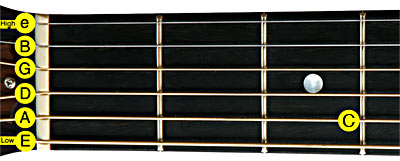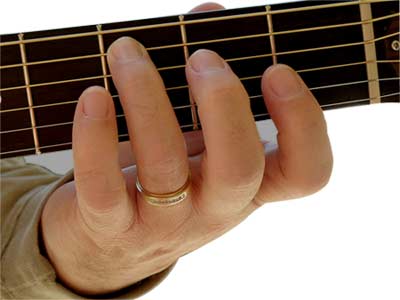The First Position C Scale
For most beginners, the first position C scale is the first scale they learn.
Understanding scales and playing scales on guitar is important for three reasons: it leads to a better understanding of music, it helps you learn the fretboard, and it improves your ability to play solos.
The C Major scale a great scale to begin with because you don't have to worry about sharps and flats. Don't let the lack of sharps and flats fool you though... all the rules about major scales apply to the C scale, it's just that when you apply the rules, you always end on a whole note.
| SIDEBAR: This article describes how to construct and play the first position C scale on guitar. The terms C scale and C Major scale mean the same thing, and are used interchangeably. |
| SIDEBAR: First Position means that your index finger naturally plays the first fret notes (right next to the nut). Second position means that your hand has moved to where your index finger naturally falls onto the second fret. And so on... |
A Quick Refresher
On the Scale Theory page, you learn that every major scale is formed by two tetrachords joined together by a whole step.
A tetrachord is four notes the follow the pattern: whole-step, whole-step, half-step.
Notes of a C Major Scale
To determine the notes of the C Major scale:
- Write out the chromatic scale,
- Beginning at the root of the scale (C), create a tetrachord,
- Add a whole step,
- Create a second tetrachord.
Let's walk through each step.
Step 1. Write out the chromatic scale. Since we're creating a C major scale, write out the chromatic scale beginning at the root (C):
C C# D D# E F F# G G# A A# B C
Step 2. Starting on the root of the scale we wish to create (C), form the first tetrachord. To form the tetrachord begin with C, add a whole-step to determine the second note (D), then another whole-step (to E), and finally, a half-step (to F).
C D E F
W W h
Step 3. Next add a whole-step to the last note of the tetrachord (F). That means our second tetrachord will begin with a G.
Step 4. Using the same pattern (whole-step, whole-step, half-step), our second tetrachord is:
G A B C
W W h
So, the C major scale uses the notes:
C D E F G A B C
W W h W W W h
<-1st tetrachord-> <-2nd tetrachord->
Now that we know the notes of the C scale, how do we play a first position C scale on guitar?
Playing The First Position C Scale on Guitar
Before we can play the scale, we need to locate the notes on the fretboard.
Most guitar fretboards have at least 20 frets. That means most notes can be played in at least two places. Which C should we pick?
I'll show one position in this lesson. A future article will show how to play second position. As your knowledge increases, will discover others on your own.
First Position C Scale
There are three benefits for beginners who learn scales in first position:
- Some of the notes are open. This gives your hands and mind a break. When you don't have to figure out which finger to press down, making certain to press it down in the right place, with the right amount of pressure... you have time to think about learning note names on the fretboard, and (eventually) which note comes next.
- Open notes are in the same position as the open chords, which are almost certainly the first chords you're learning.
- Since the frets are widest (apart) in first position, playing scales here is a good finger stretching exercise.
The best C note to begin our first position scale is middle-C, located on the fourth string at the third fret.

Place your hand in first position. Press your ring finger down on the third fret of the A string, and pluck the C note.
Tips: Keep your thumb opposite your middle finger and near the middle-back of the neck. Keep your other fingers off the fret-board, but in position for use. Keep your wrist straight. Relax your hand.

Only the ring finger is pressing on a fret, the others are ready for use.
Here's the TAB for the entire first position C scale, showing frets to play, which finger to use, and the note you're playing:
-----------------------------------------------
------------------------------0----1-----------
---------------------0----2--------------------
--------0----2---3-----------------------------
----3------------------------------------------
-----------------------------------------------
3 open 2 3 open 2 open 1 <- Finger
C D E F G A B C <--Note
Keys:
- Don't worry about speed (yet)...
- It's OK to look at the frets the first few times, but you're better off in the long-run if you don't have to look at your hands...
- As you pluck each string, fix any buzzing or dead-sounding strings...
- Use only your fingertips to press down on the strings, and stay close to the fret-wire.
This video shows how to play the first position C scale:
Related Articles
If you've enjoyed this article on the first position C scale, you might also enjoy information on scales and music theory.
- Basic Music Theory - Learn about the foundations of music: tempo, pitch, note duration, the grand staff... more.
- Basic Chord Theory - Learn what a chord is, how chords are constructed, and how you can devise any chord.
- Scale Theory - Understand concepts such as whole-steps, half-steps, chromatic scales, tetrachords, and why they are important for scale construction.


